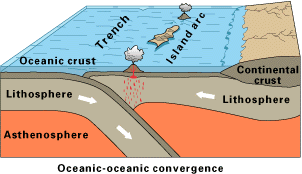Sea Floor Dynamics as Evidence of Plate Tectonics
Very large structures in the deep oceans may be studied without the effects of the weathering that tends to obscure continental features over long time periods. These large structures include deep trenches and long ridges where new material is added to the seafloor. These features can be successfully modeled with plate tectonics.
The dramatically deep trenches in the ocean floor can be modeled with convergent boundaries of plates.
 |
When two oceanic plates converge, one is usually subducted under the other, and in the process a trench is formed. "The Marianas Trench (paralleling the Mariana Islands), for example, marks where the fast-moving Pacific Plate converges against the slower moving Philippine Plate. |
The Challenger Deep, at the southern end of the Marianas Trench, plunges deeper into the Earth's interior (nearly 11,000 m) than Mount Everest, the world's tallest mountain, rises above sea level (about 8,854 m)."USGS
| Long ridge structures are found on the seafloor, the longest of which is the Mid-Atlantic Ridge. This feature can be modeled as a divergent boundary between plates. |

|
|
Index
Geophysics concepts |

